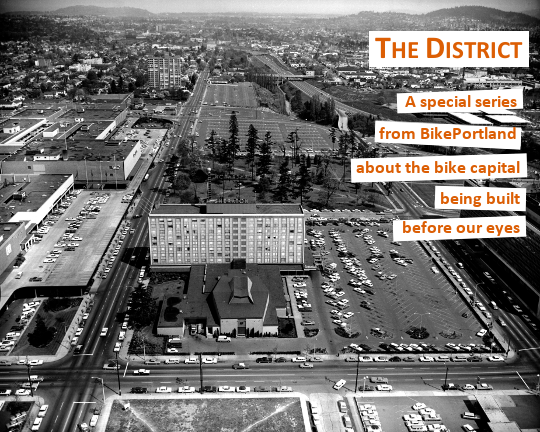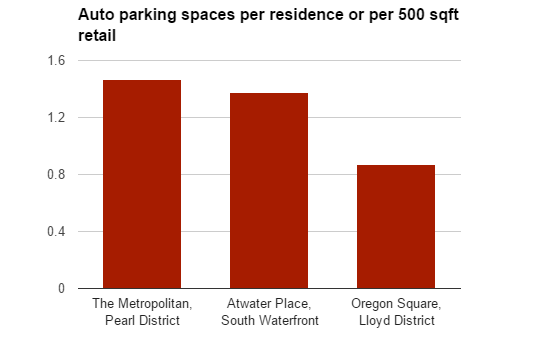This is the first in a three-part series made possible by Hassalo on Eighth.
At first glance, the changes sweeping across the Lloyd District right now look like a story Portland has told at least twice before.
Developer makes big bet on underused land near downtown. Residential towers shoot up. Amenities multiply. Streetcar whistles through. Bikes roll in by the hundreds and eventually the thousands.
But the true story of the Lloyd District, though it’s still being written, isn’t actually like that of the Pearl or South Waterfront before it.
It’s far stranger — and far more important for the rest of the world to understand.
As the first in a flurry of huge planned or proposed apartment buildings opens to residents this month in the Lloyd District, BikePortland is doing something new, too: we’re publishing a three-part series, told over the next six weeks, about the past, present and future of a neighborhood that could one day be the single most important hub of bicycling in the United States.
It’s easy to explain why the Lloyd has so much potential: unlike either of its predecessors, the Lloyd is poised to add thousands of residential units right in the middle of the country’s largest grid of connected bikeways.
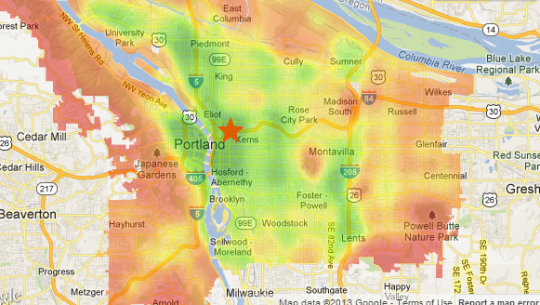
“I think the city kind of missed the ball on biking in the Pearl,” said Iain MacKenzie, a Northwest Portland resident who publishes the website NextPortland.com about urban development. “Bicycling is a lot more on everybody’s radar now, both the city’s and private developers’, than it ever was in the 90s.”
The Lloyd District seems likely to become the most bike-oriented high-rise neighborhood in the United States.
Bike infrastructure in the Lloyd has a long way to go. We’ll be discussing the changes that’ll be needed in Part III of this series.
But here’s the bottom line: if current plans for the Lloyd District move forward, one in 50 renter households in the entire City of Portland will live in one of three new apartment projects, all within a five-minute walk of one another — and all within a 15-minute bike trip of the central city’s 135,000 jobs. That’d be just the beginning; if these projects are built as proposed, it could prompt a string of parking lots owned by Kaiser Permanente to become new towers of their own, adding further to the district’s impact.
The most remarkable thing about the Lloyd’s impending transformation, though, isn’t where the district is. The most remarkable thing about the Lloyd’s transformation is what the district is.
The Lloyd District was, 20 years ago, essentially a suburban-style office park with an auto-oriented shopping mall in the middle of it.
If Portland can continue seamlessly transitioning the Lloyd District from a drive-alone employment zone that rolls up its sidewalks at 5:30 p.m. into a beating heart of east-side street life, it won’t just have created the most bike-oriented high-rise neighborhood in the United States. It’ll have written a guide for how to build such a hub out of a sea of corporate parking lots.
“I’m incredibly optimistic about that area,” said MacKenzie, who said that the Lloyd is on the way to being maybe the country’s most important biking neighborhood. “In 20 years, they aren’t going to believe what it was like a few years ago.”
This series will tell the story of what is making this transformation possible.
The day everything changed: Sept. 15, 1997
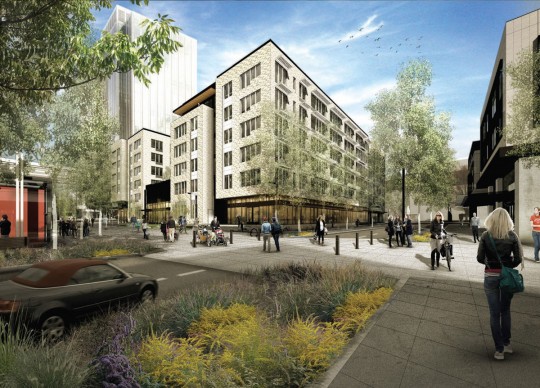
(Rendering by GBD Architects)
Before we explore the Lloyd’s history and future in the next two posts, though, it’s worth spending a little time asking just how successful the Lloyd District has been already. Here’s a good place to start:
Portland’s goal to quadruple bike use, triple transit use, double walking and cut driving in half between 2010 and 2030 has been described as unrealistic by many people, including Mayor Charlie Hales during his 2012 campaign. (In the next breath, Hales added that the goal is “ambitious” and “wonderful.”)
But that’s almost exactly what the Lloyd District did between 1994 and 2013.
“When we began in the Lloyd District, less than 10 percent of employees in the district took the bus,” Rick Williams, the founding director of the Lloyd District business association Go Lloyd, said in an interview Tuesday. “Less than 1 percent rode their bike and less than a half percent walked.”
Advertisement
For Williams, it’s easy to pinpoint the day everything began to change for the Lloyd: Sept. 15, 1997.
That was the Monday morning when the Lloyd District flipped its first 1,000 parking meters into action.
“Our goal was to get 20,000 employees into the district. Not six, not 10. And the only way to get 20,000 into the district was we had to put up bigger buildings. And the only way to put up bigger buildings was to get away from surface parking.”
— Rick Williams, founding director of Go Lloyd
For people parking on the streets, it was a 35-cent-per-hour annoyance; for people commuting to work in the district, it was a $40-per-month expense as some employers began to charge, too. But in combination with huge investments in local public transit and a steady flow of biking and walking projects, the district’s abandonment of free parking set the stage for its redevelopment.
“Our goal was to get 20,000 employees into the district,” Williams said. “Not six, not 10. And the only way to get 20,000 into the district was we had to put up bigger buildings. And the only way to put up bigger buildings was to get away from surface parking.”
So, starting in 1994, the district’s landowners hired Williams to create a new sort of business association for the area: one with a mandate to break the chokehold that auto parking had over the district by improving the district’s non-auto transportation options.
We’ll explore this history a bit more in the second post of this series, coming in a couple weeks. But here’s a spoiler: the plan worked. Here’s a chart of the on-site parking at three major mixed-use projects, one in each of the city’s major redevelopment districts during the last decade. The first two were built in 2007; the third, the planned 980-unit Oregon Square project in the Lloyd, is going before the city’s design commission next month.
Though the buildings currently going up in the Lloyd, just to the north of the Oregon Square site, have much higher parking ratios for retail space, that’s largely because the developer is trying to lure a grocery store as an anchor for the district. Hassalo on Eighth is setting aside just one residential parking space per two apartments.
Unless you count bike parking, that is. As we reported last year, Hassalo on Eighth is the biggest bike parking project in North America, a record that seems most likely to be broken by other buildings being proposed in the Lloyd District.
If these plans keep moving forward, the Lloyd District won’t be on its way to becoming Portland’s least auto-oriented new neighborhood. It’ll already be there.
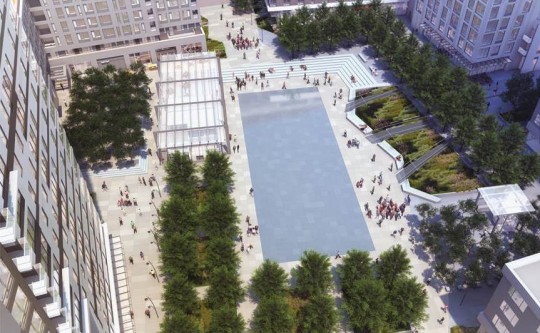
(Rendering: GBD Architects)
Coming in two weeks: How the Lloyd woke up from its century of broken dreams.
Coming in four weeks: The bikeways the district’s advocates are lining up that’ll be needed to make this dream come true.
— The Real Estate Beat is a regular column. You can sign up to get an email of Real Estate Beat posts here, or read past installments here. This is a sponsored series by BikePortland. It’s brought to you by the bike-loving folks at Hassalo on Eighth, the Lloyd District development that is now leasing. We agreed on the subject of the series but they have no control or right to review the content before publication.

